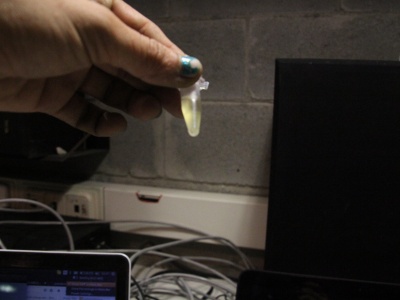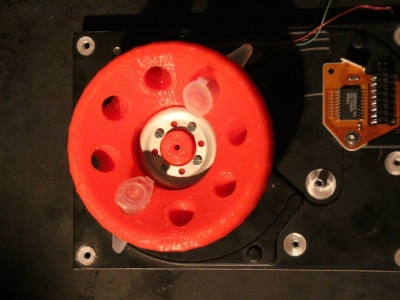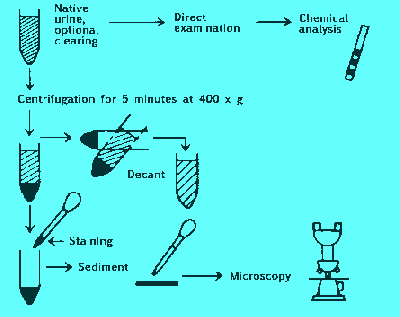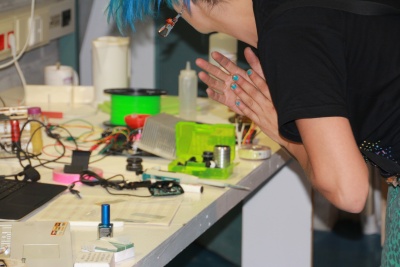Difference between revisions of "Urine analisis/MICROSCOPY"
| (5 intermediate revisions by 2 users not shown) | |||
| Line 1: | Line 1: | ||
| + | file:///home/pech/Pictures/2015/05/06/IMG_9722.JPG | ||
| + | [[Category:GynePunk]] | ||
| − | + | '''Urineanalisis''' | |
| − | + | learn how to make a wet mount to be allow to check samples through microscopes. | |
| + | == making wet mount for a microscope in general == | ||
| − | == ' | + | https://www.youtube.com/watch?feature=player_embedded&v=qSsMe_OXv-0 |
| − | + | ||
| + | == now let's go to make the step by step to get the urine prepared to especulation== | ||
| + | |||
| + | check how to use the centrifuge to separate solid components of the urine from the liquid [[http://hackteria.org/wiki/Urineanalisis]] | ||
| + | |||
| + | connecting Gynepunk node from Barcelona to Gaudi Labs into Lucern. | ||
| + | |||
| + | == Basic steps to get the urineanalisis:== | ||
| + | |||
| + | 1-clean a bit the area. | ||
| + | |||
| + | 2- get a sterilize recipy and put your pee inside | ||
| + | |||
| + | 3- get a eppendorf and put 1ml of urine inside like this : | ||
| + | |||
| + | [[File:urine0.JPG|400px]] | ||
| + | |||
| + | 4- put the sample with the eppendorf and urine into the gynepunk centrifuge and turns the centrifuge 10 minutes max. speed : | ||
| + | [[File:gynefuge.jpg|400px]] | ||
| + | 5- you can see now how the solid parts of urine are at the botton, take a syringe and with care take out all the liquid first, throw it away and then you need to take the small amount of solid components. | ||
| − | + | check here to follow better the prutocul | |
| + | [[File:urineappendolf.gif|400px]] | ||
| + | 4- get a microscope slide and put one dot of solid compound from urine, put a cover on top of it and then use nail polish to keep the wet mount prepared to use with the microscope. | ||
| − | |||
| − | |||
| − | |||
| + | [[File:wetmount.JPG|400px]] | ||
| − | + | 5- check what you see under the microscope | |
| − | + | [[File:microscopeTHf.JPG|400px]] | |
| − | + | [[File:microscopeTHf.JPG|400px]] | |
| − | |||
| − | |||
| − | |||
| − | + | 6- some references to don't get complete lost | |
| − | + | imagen de los componentes y afecciones relativas a la urina ( buscar ) | |
| − | |||
| − | |||
| − | |||
| − | |||
| − | |||
| − | |||
| − | + | == Observing bacteria under the light microscope == | |
| + | |||
| − | + | == Why bacteria are difficult to see == | |
| + | Can one see bacteria using a compound microscope? The answer is a careful “yes, but”. | ||
| + | Generally speaking, it is theoretically and practically possible to see living and unstained bacteria with compound light microscopes, including those microscopes which are used for educational purposes in schools. There are several issues to consider, however. | ||
| − | |||
| − | + | Bacteria are difficult to see with a bright-field compound microscope for several reasons: | |
| − | + | They are small: In order to see their shape, it is necessary to use a magnification of about 400x to 1000x. The optics must be good in order to resolve them properly at this magnification. | |
| + | Difficult to focus: At a high magnification, the bacterial cells will float in and out of focus, especially if the layer of water between the cover glass and the slide is too thick. | ||
| + | They are transparent: Bacteria will show their color only if they are present in a colony. Individual cells present on the slide are clear. Regular bright-field optics will only show the bacteria if one closes the condenser iris diaphragm. This is due to the difference in the refractive index between the water and the bacterial cells. | ||
| + | Difficult to recognize: An untrained eye may have problems differentiating bacteria from small dust and dirt which is present on the slide. Some bacteria also form clumps and therefore it is difficult to see the individual cells. | ||
| + | Research organizations and advances amateurs use phase contrast optics to see bacteria. This system converts the differences of the refractive index of the bacteria into brightness. The transparent bacteria can then be seen dark on bright background. In bright-field, closing the condenser iris diaphragm will also make the bacteria appear darker, but at the same time one also introduces artifacts (“fringes”) around the individual cells. One possibility is to stain the bacteria, but in this case there fixing and staining process may introduce artifacts. | ||
| + | What is a safe source of bacteria? For recreational or educational purposes, one should never use spoiled food or (heaven forbid!) use bacteria obtained from the human body and grown on agar plates. The risks involved are simply not worth it, especially when working with students. Other sources, such as soil or humus have other disadvantages. The impurities make it difficult to keep bacteria from other particles apart, especially if one uses bright-field optics. Rather I recommend the use of yogurt. It should be possible to see small circular cells (cocci), which may also occur in pairs. It is also possible to scratch some bacterial cells off from certain kinds of cheese. Brevibacterium can be found on Limburger cheese, for example. One has to be aware that some cheeses use a combination of bacteria and fungi, however, and that the larger fungal cells may outweigh the bacteria. | ||
| + | In summary, there are easier (and maybe also more interesting) specimens to observe than bacteria. I you want to see individual cells, then I do recommend that you start out with yeast suspensions. These eukaryotic cells are much larger and can be more easily identified. | ||
| − | + | For pictures of bacteria in phase contrast read the following post: Bacteria in phase contrast | |
| − | |||
| − | |||
| − | |||
| − | |||
| − | |||
| − | |||
| − | |||
| − | |||
| − | |||
| − | |||
| − | |||
| − | |||
| − | |||
| − | |||
| − | |||
| − | |||
| − | |||
| − | |||
| − | |||
| − | |||
| + | == An exploration of your house in close-up . Studying motion== | ||
| + | http://www.microscopy-uk.org.uk/dww/home/hombrown.htm | ||
| + | What you need: | ||
| + | A compound microscope capable of 200X or 400X magnification. | ||
| + | Clean slides and coverslips. | ||
| + | Distilled water (the water collected from the ice box when defrosting the fridge is an acceptable substitute). | ||
| + | One or more of: talcum powder, pasteurised milk. | ||
| − | + | ||
| + | |||
| + | == dreaming with have one of this ones == | ||
| Line 110: | Line 120: | ||
| + | == super nice hack : == | ||
| + | |||
| − | + | http://journals.plos.org/plosone/article?id=10.1371/journal.pone.0098781 | |
| − | http:// | ||
| − | |||
| − | |||
| − | |||
| − | |||
| − | |||
| − | |||
| − | |||
| − | |||
Latest revision as of 20:46, 20 May 2015
file:///home/pech/Pictures/2015/05/06/IMG_9722.JPG
Urineanalisis
learn how to make a wet mount to be allow to check samples through microscopes.
Contents
- 1 making wet mount for a microscope in general
- 2 now let's go to make the step by step to get the urine prepared to especulation
- 3 Basic steps to get the urineanalisis:
- 4 Observing bacteria under the light microscope
- 5 Why bacteria are difficult to see
- 6 An exploration of your house in close-up . Studying motion
- 7 dreaming with have one of this ones
- 8 super nice hack :
making wet mount for a microscope in general
https://www.youtube.com/watch?feature=player_embedded&v=qSsMe_OXv-0
now let's go to make the step by step to get the urine prepared to especulation
check how to use the centrifuge to separate solid components of the urine from the liquid [[1]]
connecting Gynepunk node from Barcelona to Gaudi Labs into Lucern.
Basic steps to get the urineanalisis:
1-clean a bit the area.
2- get a sterilize recipy and put your pee inside
3- get a eppendorf and put 1ml of urine inside like this :
4- put the sample with the eppendorf and urine into the gynepunk centrifuge and turns the centrifuge 10 minutes max. speed :
5- you can see now how the solid parts of urine are at the botton, take a syringe and with care take out all the liquid first, throw it away and then you need to take the small amount of solid components.
check here to follow better the prutocul
4- get a microscope slide and put one dot of solid compound from urine, put a cover on top of it and then use nail polish to keep the wet mount prepared to use with the microscope.
5- check what you see under the microscope
6- some references to don't get complete lost
imagen de los componentes y afecciones relativas a la urina ( buscar )
Observing bacteria under the light microscope
Why bacteria are difficult to see
Can one see bacteria using a compound microscope? The answer is a careful “yes, but”. Generally speaking, it is theoretically and practically possible to see living and unstained bacteria with compound light microscopes, including those microscopes which are used for educational purposes in schools. There are several issues to consider, however.
Bacteria are difficult to see with a bright-field compound microscope for several reasons:
They are small: In order to see their shape, it is necessary to use a magnification of about 400x to 1000x. The optics must be good in order to resolve them properly at this magnification. Difficult to focus: At a high magnification, the bacterial cells will float in and out of focus, especially if the layer of water between the cover glass and the slide is too thick. They are transparent: Bacteria will show their color only if they are present in a colony. Individual cells present on the slide are clear. Regular bright-field optics will only show the bacteria if one closes the condenser iris diaphragm. This is due to the difference in the refractive index between the water and the bacterial cells. Difficult to recognize: An untrained eye may have problems differentiating bacteria from small dust and dirt which is present on the slide. Some bacteria also form clumps and therefore it is difficult to see the individual cells.
Research organizations and advances amateurs use phase contrast optics to see bacteria. This system converts the differences of the refractive index of the bacteria into brightness. The transparent bacteria can then be seen dark on bright background. In bright-field, closing the condenser iris diaphragm will also make the bacteria appear darker, but at the same time one also introduces artifacts (“fringes”) around the individual cells. One possibility is to stain the bacteria, but in this case there fixing and staining process may introduce artifacts.
What is a safe source of bacteria? For recreational or educational purposes, one should never use spoiled food or (heaven forbid!) use bacteria obtained from the human body and grown on agar plates. The risks involved are simply not worth it, especially when working with students. Other sources, such as soil or humus have other disadvantages. The impurities make it difficult to keep bacteria from other particles apart, especially if one uses bright-field optics. Rather I recommend the use of yogurt. It should be possible to see small circular cells (cocci), which may also occur in pairs. It is also possible to scratch some bacterial cells off from certain kinds of cheese. Brevibacterium can be found on Limburger cheese, for example. One has to be aware that some cheeses use a combination of bacteria and fungi, however, and that the larger fungal cells may outweigh the bacteria.
In summary, there are easier (and maybe also more interesting) specimens to observe than bacteria. I you want to see individual cells, then I do recommend that you start out with yeast suspensions. These eukaryotic cells are much larger and can be more easily identified.
For pictures of bacteria in phase contrast read the following post: Bacteria in phase contrast
An exploration of your house in close-up . Studying motion
http://www.microscopy-uk.org.uk/dww/home/hombrown.htm
What you need:
A compound microscope capable of 200X or 400X magnification. Clean slides and coverslips. Distilled water (the water collected from the ice box when defrosting the fridge is an acceptable substitute). One or more of: talcum powder, pasteurised milk.
dreaming with have one of this ones
http://bestcompoundmicroscopes.com/ http://www.amazon.com/gp/product/B005TJ5CEG/ref=as_li_qf_sp_asin_il_tl?ie=UTF8&camp=1789&creative=9325&creativeASIN=B005TJ5CEG&linkCode=as2&tag=bestcompoundmicroscopes-20
Do-it-yourself guide: How to use the modern single molecule toolkit http://www.ncbi.nlm.nih.gov/pmc/articles/PMC2574008/
super nice hack :
http://journals.plos.org/plosone/article?id=10.1371/journal.pone.0098781



